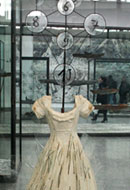Kiefer's Challenge

The German artist Anselm Kiefer has once again taken New York by storm. Ensconced at the prestigious Gagosian Gallery, Next Year in Jerusalem, his latest show, has met with reviews ranging from the gushing to the grudgingly respectful. To Roberta Smith, the veteran New York Times art critic, the massive exhibit, which closes December 18, is "possibly the best [Kiefer] has ever mounted in the city," even as Smith also comments, more caustically, that it amounts to "middlebrow art as catharsis, spectacle with a message."
Indeed, Kiefer's trademark subject matter of heavy-handed German angst and guilt may no longer be cool enough for the art journals and chat rooms. But the show and its provocative title carry a special message for Jews, and for Jewish artists.
More a massive installation than an exhibition, the show features 25 glass cases, many fifteen feet high or more, each containing a discrete sculpture: self-enclosed tableaus dominated by biblical and Jewish themes including (his titles) Jacob's Ladder, Lilith, Lilith's Daughter, the Tree of Jesse, Jeremiah, Baruch, Jehoiakim, "I Shall Be What I Shall Be," "In the Beginning," Fallen Angel, Sephirot, Shekhinah, and Destruction of the Temple. Each title is handwritten on one or more sides of the vitrine so that the text both merges and interferes with the images inside. Studying the extensive glossary necessary to understand the symbolic works, visitors, constantly visible through the glass, become participants in this quasi-biblical landscape.
Kiefer anchors the biblical with the personal—a steel enclosure the size of a one-bedroom apartment contains 76 large-scale photos mounted on lead of a young Anselm Kiefer giving the Nazi salute—and with a scattering of World War II, Christian, and Gnostic subjects. Surrounding everything are thirteen enormous paintings of torturous mountain landscapes, dark German forests, and headless birds of prey. Gray, black, and white dominate these deeply pessimistic symbolic meditations. Constant references to Kabbalah, memory, and mortality ground the cases of burned books, bare branches, rocks, paint-splattered dresses, and decrepit clothing in a gravitas (or portentousness) hard to deny.
Easily the most arresting work is the vitrine containing the Shekhinah. Considering the fact that Kiefer never depicts the human form, this white wedding dress is the most evocative image on display. Pierced by shards of glass and supported by the bottommost section of a steel sculpture of the ten kabbalistic sephirot emerging out of her body, it resembles, in its own bizarre manner, some ancient reliquary. The case purports to chart the body of the divine and its shattered relationship to the mundane world, exploring the pain of the divine presence trapped with an all too imperfect human mate.
Indeed, if there is a dominant motif in the exhibition, it lies in this steady allusion to the hopelessly vertical relationship between the supernal and the mundane. Many objects are tethered to the glass ceiling of their cases, suggesting an earthly marionette controlled by heaven. The point for Kiefer is that the world is a dour theater in which mankind's fate is subject to mythic forces of evil and destruction. In the hefty catalogue, he relates a midrash: "Man, says Rabbi Eliezer, is a piece [of string] at whose ends God and Satan are pulling; in the end, God is clearly the stronger." He adds: "I, on the other hand, believe the outcome is undecided."
Ultimately, Kiefer's grim, physically imposing vision, representing an enormous investment of time and money, and purporting to deal with multiple weighty subjects, offers more flash than substance—and does so with an annoying sameness of color, form, and texture. Where he utilizes Jewish subjects, Kiefer ignores their narrative potential in favor of the ghostly, producing a grandiose piece of theater that borders on the superficial.
But in a way this is quite beside the point. After carefully building an exceptional career for over 30 years, Kiefer is now world-famous and can do pretty much what he wants in the high-priced stratosphere of postmodern art. But he intrigues despite his shallowness. In this instance, what intrigues is the audacious use of blatantly Jewish material. To behold the members of a chic New York art crowd dutifully clutching their glossaries and solemnly pondering God's utterances from the Burning Bush, the female aspect of the divine wounded in exile, or the notion of a ladder to heaven is an amazing sight.
Jewish motifs are not new with Kiefer. His exhibition at the Israel Museum in the 1980's legitimized his use of such themes, and he has steadfastly continued to explore them. In doing so, moreover, he has audaciously worked against the grain of received modern opinion (negative) when it comes to religion. How has he gotten away with it? In the catalogue, the historian Marina Warner speculates that "Kiefer's is the art of an artist in a context of religion without religion, the fruit of an unbeliever."
Perhaps so. Or perhaps Kiefer's choice of religious themes is peculiarly well suited to vaguely "universal" interpretations. The real question is: could a Jew do this? More pointedly, could a Jewish artist with the courage to commit himself to Jewish subject matter, the stamina to persevere, and the talent to back it up overcome the resistance, much of it from Jews, to authentic Judaic themes in contemporary art? Until someone gives it a shot, we will never know.
Richard McBee is a painter and writer on Jewish art.
Comments are closed for this article.




